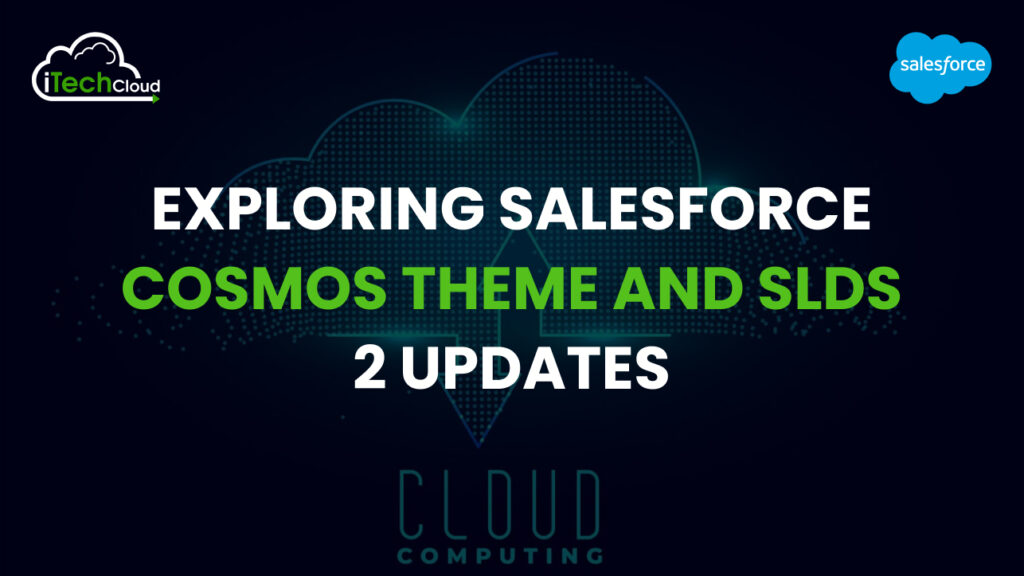Exploring Salesforce Cosmos Theme and SLDS 2 Updates

Salesforce continues to redefine the user experience (UX) with its latest innovations, and the introduction of the Cosmos Theme alongside the updates to Salesforce Lightning Design System (SLDS) 2 is no exception. These changes bring a fresh and intuitive interface that enhances usability, accessibility, and consistency across Salesforce platforms. Whether you are a Salesforce administrator, developer, or designer, understanding these updates is crucial for optimizing your Salesforce instance and ensuring a seamless user experience.
Table of Contents
What is the Salesforce Cosmos Theme?
The Cosmos Theme is Salesforce’s latest UI framework designed to provide a cleaner, more modern, and highly efficient interface. This theme introduces a more consistent design language that aligns with modern web standards and makes it easier for users to navigate and interact with the Salesforce platform.
SLDS 2 (Beta)
Introduces the newest design system for Lightning Platform solutions, blending the Salesforce Cosmos theme with an improved design framework and upgraded tools. It offers greater flexibility, empowering admins, developers, and designers to personalize and enhance brand identity seamlessly.
The Benefits of SLDS 2 For Admins
Salesforce Lightning Design System (SLDS) 2 offers numerous advantages to Salesforce admins by ensuring consistency, improving user experience, and simplifying customization.
✅ Consistent UI and UX:
SLDS 2 maintains a uniform look across custom components, aligning them with the standard Salesforce Lightning Experience. This consistency boosts user adoption and enhances familiarity.
⚡ Declarative Customization:
Admins can easily customize record pages and layouts using tools like Lightning App Builder and Dynamic Forms without writing code. SLDS components can be utilized in App Builder to ensure consistent styling.
🔒 Improved Security and Compliance:
SLDS 2 follows Salesforce’s security standards and adheres to WCAG 2.1 guidelines for accessibility, minimizing vulnerabilities and ensuring a secure user experience.
📚 Simplified Maintenance:
As SLDS 2 reduces the need for manual CSS and design updates, admins can effortlessly maintain and update custom apps. SLDS components automatically adapt to platform updates, reducing maintenance effort.
🚀 Increased Productivity:
Pre-built SLDS components save time by enabling admins to quickly configure pages, workflows, and apps. This reduces reliance on developers and empowers admins to create rich interfaces independently.
🔄 Seamless Upgrades:
SLDS 2 is automatically updated with Salesforce releases, ensuring that custom interfaces remain aligned with the platform’s latest features without requiring manual intervention.
🧩 Drag-and-Drop Components:
SLDS-compatible components can be easily added using drag-and-drop functionality in Lightning App Builder, simplifying page creation.
📊 Better User Adoption:
A familiar and consistent interface improves user adoption, resulting in higher productivity and satisfaction.
🎯 Flexibility and Extensibility:
Admins can enhance standard functionality with SLDS-styled custom components, improving the user experience without compromising performance.
📢 Communication:
SLDS 2 establishes a shared design language between admins and developers, minimizing miscommunication and ensuring smooth collaboration.
Benefits of SLDS 2 For Developers and Designers
Salesforce Lightning Design System (SLDS) 2 offers numerous benefits for both designers and developers, enhancing the efficiency, consistency, and usability of applications on the Salesforce platform.
🎨 Benefits for Designers:
1. Consistency Across Apps:
Ensures a unified design language across applications, allowing designers to focus on UX without worrying about UI inconsistencies.
2. Predefined Design Patterns:
Provides ready-to-use patterns, color palettes, and typography aligned with Salesforce standards, saving time and effort.
3. Scalability and Reusability:
Design assets can be reused across multiple projects, ensuring a cohesive look and simplifying updates as SLDS evolves.
4. Faster Prototyping:
Component-based design accelerates the prototyping process with ready-made components for wireframes and prototypes.
5. Improved Accessibility:
Adheres to WCAG 2.1 standards, ensuring designs are accessible, with built-in ARIA roles and semantic HTML for better screen reader support.
💻 Benefits for Developers:
1. Rapid Development with Pre-Built Components:
Offers a wide range of customizable, pre-built components, enabling developers to focus more on functionality than UI development.
2. Clean and Maintainable Code:
Encourages modular, reusable code with scoped CSS, reducing conflicts and minimizing the need for custom styling.
3. Improved Performance:
Optimizes page load speeds through lightweight CSS and JavaScript, supporting lazy loading and asset optimization.
4. Flexibility and Customization:
Allows developers to customize components without affecting core functionality, thanks to its modular architecture.
5. Responsiveness and Mobile-First Design:
Ensures applications are fully responsive and mobile-friendly with grid systems and layout utilities for adaptive designs.
SLDS 2 Features
1. Themes and Branding:
SLDS 2 introduces an extensive collection of pre-built themes that allow for seamless customization of your Salesforce interface. Additionally, you can craft your own themes, leveraging a more diverse and expanded color palette. This enhanced flexibility empowers you to fine-tune the visual identity of your platform, ensuring it aligns perfectly with your brand.
2. Salesforce Cosmos Theme:
Within the Themes and Branding section, the Salesforce Cosmos theme brings a contemporary, user-friendly design aesthetic. It incorporates circular visual elements, a revitalized color scheme, and refined typography, all of which contribute to a more visually engaging and intuitive user interface.
3. Advanced Figma Kits:
SLDS 2 provides upgraded Figma kits that offer precise design-to-code alignment. These kits come with pre-styled components and guide both developers and designers through the integration of SLDS-compliant elements. The kits ensure consistency across the design and development process by mapping styles directly to code.
4. Developer Tools:
Enhanced developer utilities include advanced rule sets, detailed inline guidance, and bulk reporting capabilities. These tools give developers increased control, efficiency, and the ability to apply more granular configurations to their UI designs.
5. User Personalization Options:
SLDS 2 introduces greater personalization through user-specific controls and density preferences. Users can modify their UI experience to better suit their preferences, enhancing both usability and comfort.
6. SLDS 2 Architecture:
The architecture of SLDS 2 is built on a foundation of styling hooks, which provide a flexible and robust framework for adjusting UI appearance. These global styling hooks allow developers to dynamically modify styles across components with ease. Moreover, Lightning Base Components remain the cornerstone of design in SLDS 2, serving as the preferred solution for building AI-ready and future-proof components.
SLDS 2 and Salesforce Cosmos Availability by Salesforce Product and Feature
Salesforce Lightning Design System (SLDS) 2 introduces new features, including the Salesforce Cosmos Theme, enhanced Themes and Branding, improved Architecture, and advanced Personalization. While some of these features are generally available (GA), many are still in beta and being gradually rolled out based on product type and edition. Below is a detailed breakdown:
1. Salesforce Cosmos Theme Availability
- Starter and Pro Suite Editions:
- The Salesforce Cosmos Theme is generally available (GA) from Summer ’24 for both new and existing organizations, and it is enabled by default.
- Sales Cloud (All Editions):
- GA for New Orgs: Enabled by default starting from Summer ’24.
- Beta for Existing Orgs: Available as an opt-in feature in Spring ’25.
- Service Cloud (Professional and Enterprise Editions):
- GA for New Orgs: Enabled by default starting from Winter ’25.
- Beta for Existing Orgs: Available as an opt-in feature in Spring ’25.
- Service Cloud (All Other Editions):
- Available in Spring ’25 as a beta opt-in feature for both new and existing organizations.
- All Other Salesforce Products:
- The Salesforce Cosmos Theme will be available in Spring ’25 as a beta opt-in feature for both new and existing organizations.
2. SLDS 2 Themes, Branding, Architecture, and Personalization Availability
These features, including updated themes, flexible branding, improved architecture, and personalized user experiences, are currently in beta for all Salesforce products and editions. They are expected to move towards GA in future releases, but for now, they remain as opt-in beta features across the board.
3. Summary of Rollout Timeline
- Summer ’24: GA for Starter and Pro Suite (Cosmos Theme enabled by default).
- Summer ’24: GA for new Sales Cloud orgs; beta opt-in for existing orgs in Spring ’25.
- Winter ’25: GA for new Service Cloud (Professional and Enterprise) orgs; beta opt-in for existing orgs in Spring ’25.
- Spring ’25: Beta opt-in for all other Service Cloud editions and all other Salesforce products.
Conclusion:
Salesforce Cosmos Theme and SLDS 2 bring a modernized user experience with enhanced themes, branding, architecture, and personalization. While the Cosmos Theme is generally available for Starter and Pro Suite editions from Summer ’24 and expanding to Sales and Service Cloud editions through Spring ’25, most SLDS 2 features remain in Beta across all editions.
As Salesforce continues refining these features, organizations can gradually adopt these updates, ensuring a seamless transition to a more personalized and visually enhanced platform. Businesses should stay informed on future releases to maximize the benefits of these innovative enhancements.

